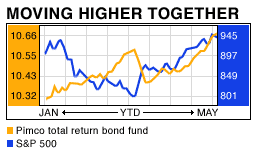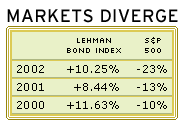NEW YORK (CNN/Money) -
Bonds and stocks, which have long gone their separate ways, both are higher in 2003, joining forces for the first time in six years.
Equity investors betting on economic recovery have helped send the Standard and Poor's 500 index up 6.5 percent this year following three straight annual declines.
Bond investors, meanwhile, are heartened by prospects for falling prices, which boost the value of a bond's fixed payments. The Lehman Brothers Aggregate Bond Index has returned 3.16 percent this year following three straight annual gains.

But analysts doubt both markets can stay aligned for long. The bond market's run, after all, can't last forever, particularly as the government sells more debt to make up for declining tax receipts.
"Personally, I think Treasury valuations are horrible," said Bill Hornbarger, head of fixed income trading at AG Edwards & Sons.
James Grant, the editor of Grant's Interest Rate Observer, takes that opinion a step further.

"The one thing that the bond and stock markets have in common is they are both very speculative," Grant said. "What neither offers is a margin of safety."
The two markets have synchronized before, mostly recently in 1998 when the term "Goldilocks economy" was used to describe growth that was not too hot, not too cold, but just right.
Things are different this time. The Federal Reserve last week signaled it was worried enough about falling prices to keep interest rates at a four-decade low for a while. That development should support bond prices.
For more on bonds click here
Mike Ryan, head of fixed income at UBS Warburg, does not expect yields to go higher until the economy strengthens, the stock market shows sustained gains and inflation begins to creep higher.
"The Fed is not going to be raising rates anytime soon," Ryan said.
That hasn't happened in a long time; Friday marks the three-year anniversary of the Fed's last rate hike.
Treasurys keep gaining
The bond surge continued Wednesday, with the yield on the 10-year note, which moves inversely to its price, falling to 3.56 percent. That matched its lowest level since 1958. Stocks slipped for a second session Wednesday but remain near their highs of the year.
Some attribute the bond market's gains to continued risk-aversion by investors smarting from the stock market's long decline. Investors poured $14.8 billion into bond mutual finds in March, according to AMG Data Services, which tracks fund flows.
At the same time, the economy remains sluggish. Data Thursday showed that retail sales fell 0.1 percent in April, defying expectations for a small gain.
To ensure that borrowing costs stay low, the Federal Reserve may start buying long-dated Treasury securities like the 10-year note, analysts say, moving beyond buying only fast-maturing Treasury bills.
But when yields eventually do rise, the end of the bond market's rally could spell disappointment for investors who poured billions of dollars into bonds and bond funds during the last three years.
Data from Vanguard, the mutual fund company, show that a half-percentage-point gain in yields will mean a 2.01 percent decline in total bond returns.
Further, a one-percentage-point gain in yields would cut total returns by 5.67 percent, while a 1.5-percentage-point-gain would erode returns by 9.17 percent. A 2-percentage-point gain would cut 12.50 percent from bond returns.
"Are we setting markets up for an abrupt and punishing bond selloff like we experienced in 1994?" asked David R. Kotok, a money manager at Cumberland Advisors. "We think so."
The stock market, meanwhile, has benefited from a quick end to war in Iraq and first-quarter profit reports that proved surprisingly buoyant. But a U.S. economy where employers have cut 2 million jobs over the last two years is not yet growing fast enough to cure the job market's problems.
Bond and stock markets often work in opposition. Low bond yields, by cheapening borrowing costs, can help the equity market by lifting corporate profits. Stocks, particularly the dividend paying kind, look less attractive when bond yields rise.
James Grant, who is wary of both U.S. stocks and bonds, sees opportunities in Japanese stocks. That country's main market index, the Nikkei, is near a 20-year low.
"You are being well paid for very well advertised risk," Grant said.

|

